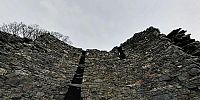
Brochs - The Beginnings of Scotland's History of Castle-Building
Glen Beag, Highland Region, Scotland, UK
Sunday 23 March 2008, 4:01 pm GMT
© 2008 Richard Crowest, All Rights Reserved.
The origins of these fortified stone buildings date back two-and-a-half millennia, to the Iron Age, before the Roman invasion of Britain. Brochs are dry-stone structures, built entirely without cement or mortar, and were originally at the heart of Celtic communities living in wooden roundhouses. Remains have been found all over Scotland, and astoundingly several, such as the two here in Glen Beag, have survived with sections of their double-walls still standing to a considerable height. The best preserved broch, at Mousa in Shetland, has a complete circular wall to over 40 feet (13 metres) high.
The space between the two circular walls contained storage areas and staircases, allowing the inhabitants to climb to a walkway round the top of the tower to keep watch or light signal fires. In times of trouble, villagers could gather inside the broch, blocking the single small entrance with a large stone or wooden door. Archaeological evidence suggests that the two brochs in Glen Beag may have been joined to each other by a tunnel, which also led to the nearby river, giving access to water.
Visit our web site for a view of the other Glen Beag broch, Dun Telve.


 Tap or click the zoom icon in the bottom right corner of the picture to switch between in-page and fullscreen view
Tap or click the zoom icon in the bottom right corner of the picture to switch between in-page and fullscreen view